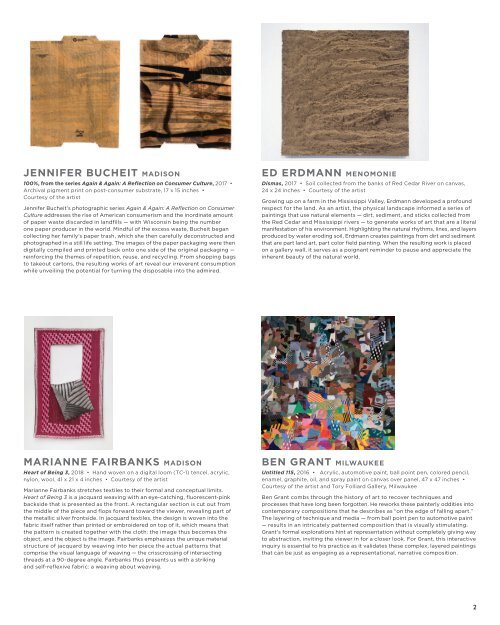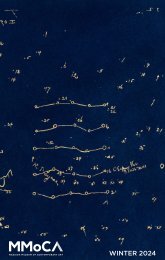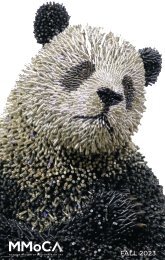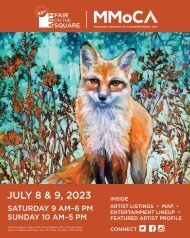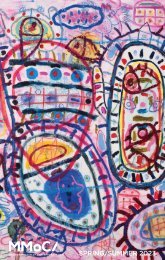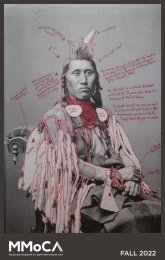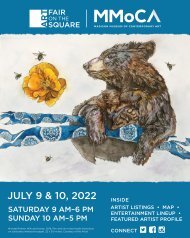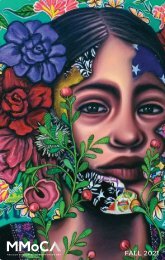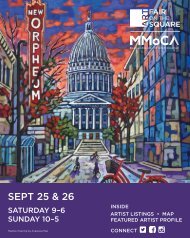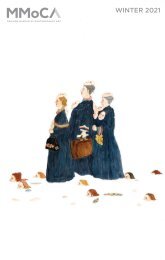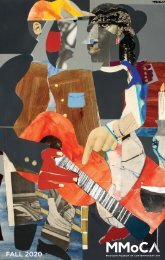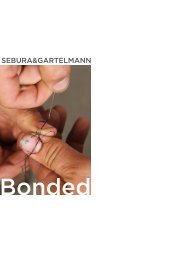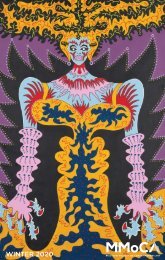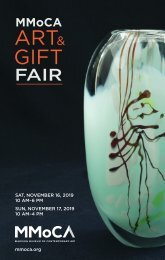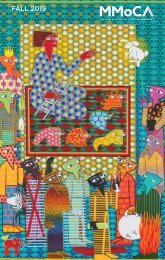Wisconsin Triennial Brochure 2019
Exhibition brochure for the 2019 Wisconsin Triennial
Exhibition brochure for the 2019 Wisconsin Triennial
Create successful ePaper yourself
Turn your PDF publications into a flip-book with our unique Google optimized e-Paper software.
JENNIFER BUCHEIT MADISON<br />
100%, from the series Again & Again: A Reflection on Consumer Culture, 2017 •<br />
Archival pigment print on post-consumer substrate, 17 x 15 inches •<br />
Courtesy of the artist<br />
Jennifer Bucheit’s photographic series Again & Again: A Reflection on Consumer<br />
Culture addresses the rise of American consumerism and the inordinate amount<br />
of paper waste discarded in landfills — with <strong>Wisconsin</strong> being the number<br />
one paper producer in the world. Mindful of the excess waste, Bucheit began<br />
collecting her family’s paper trash, which she then carefully deconstructed and<br />
photographed in a still life setting. The images of the paper packaging were then<br />
digitally compiled and printed back onto one side of the original packaging —<br />
reinforcing the themes of repetition, reuse, and recycling. From shopping bags<br />
to takeout cartons, the resulting works of art reveal our irreverent consumption<br />
while unveiling the potential for turning the disposable into the admired.<br />
ED ERDMANN MENOMONIE<br />
Dismas, 2017 • Soil collected from the banks of Red Cedar River on canvas,<br />
24 x 24 inches • Courtesy of the artist<br />
Growing up on a farm in the Mississippi Valley, Erdmann developed a profound<br />
respect for the land. As an artist, the physical landscape informed a series of<br />
paintings that use natural elements — dirt, sediment, and sticks collected from<br />
the Red Cedar and Mississippi rivers — to generate works of art that are a literal<br />
manifestation of his environment. Highlighting the natural rhythms, lines, and layers<br />
produced by water eroding soil, Erdmann creates paintings from dirt and sediment<br />
that are part land art, part color field painting. When the resulting work is placed<br />
on a gallery wall, it serves as a poignant reminder to pause and appreciate the<br />
inherent beauty of the natural world.<br />
MARIANNE FAIRBANKS MADISON<br />
Heart of Being 3, 2018 • Hand woven on a digital loom (TC-1) tencel, acrylic,<br />
nylon, wool, 41 x 21 x 4 inches • Courtesy of the artist<br />
Marianne Fairbanks stretches textiles to their formal and conceptual limits.<br />
Heart of Being 3 is a jacquard weaving with an eye-catching, fluorescent-pink<br />
backside that is presented as the front. A rectangular section is cut out from<br />
the middle of the piece and flops forward toward the viewer, revealing part of<br />
the metallic silver frontside. In jacquard textiles, the design is woven into the<br />
fabric itself rather than printed or embroidered on top of it, which means that<br />
the pattern is created together with the cloth: the image thus becomes the<br />
object, and the object is the image. Fairbanks emphasizes the unique material<br />
structure of jacquard by weaving into her piece the actual patterns that<br />
comprise the visual language of weaving — the crisscrossing of intersecting<br />
threads at a 90-degree angle. Fairbanks thus presents us with a striking<br />
and self-reflexive fabric: a weaving about weaving.<br />
BEN GRANT MILWAUKEE<br />
Untitled 115, 2016 • Acrylic, automotive paint, ball point pen, colored pencil,<br />
enamel, graphite, oil, and spray paint on canvas over panel, 47 x 47 inches •<br />
Courtesy of the artist and Tory Folliard Gallery, Milwaukee<br />
Ben Grant combs through the history of art to recover techniques and<br />
processes that have long been forgotten. He reworks these painterly oddities into<br />
contemporary compositions that he describes as “on the edge of falling apart.”<br />
The layering of technique and media — from ball point pen to automotive paint<br />
— results in an intricately patterned composition that is visually stimulating.<br />
Grant’s formal explorations hint at representation without completely giving way<br />
to abstraction, inviting the viewer in for a closer look. For Grant, this interactive<br />
inquiry is essential to his practice as it validates these complex, layered paintings<br />
that can be just as engaging as a representational, narrative composition.<br />
2


